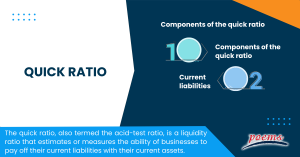Quick Ratio
Table of Contents
Quick Ratio
The quick ratio is an important financial metric that provides insights into the short-term liquidity of a business. Concentrating solely on the most liquid assets gives a more conservative estimate of liquidity compared to the current ratio. A higher quick ratio is generally more favourable because it indicates that a business has a greater cushion of liquid assets to fall back on if necessary.
What is the quick ratio?
The quick ratio, also termed the acid-test ratio, is a liquidity ratio that estimates or measures the ability of businesses to pay off their current liabilities with their current assets. In other words, it is a financial metric that provides insights into a company’s short-term liquidity.
Whenever there is an issue with cash flow, the quick ratio is a significant measure of the company’s ability to meet short-term obligations.
Several criteria determine a company’s best quick ratio. Such characteristics include the industry in which it works, the markets it covers, its maturity, the kind of company it is, the debtor-creditor cycle, and its creditworthiness.
Understanding the quick ratio
Quick ratio provides a more accurate picture of a company’s capacity to pay its debts in the short term because it excludes inventory and other assets that may not be easily converted into cash. Concentrating only on the most liquid assets, the quick ratio measures a company’s ability to meet its financial obligations quickly without selling off its inventory or other long-term assets.
A quick ratio of 1:1 implies that a company’s liquid assets are sufficient to meet its current liabilities. However, a higher quick ratio is generally considered more favourable because it indicates that a business has a greater cushion of liquid assets to fall back on if necessary. A quick ratio that is too low may indicate that a business is struggling to meet its short-term financial obligations, which could lead to cash flow problems and potentially even bankruptcy.
Quick ratio formula
The quick ratio is calculated by dividing the sum of cash, marketable securities, and accounts receivable by the current liabilities of a business. The formula for the calculation of the quick ratio is as follows:
Quick ratio = (cash + marketable securities + accounts receivable) / current liabilities
Components of the quick ratio

- Liquid or current assets
The liquid assets of a corporation are assets that are cash or equivalent to cash. Cash is one of the simpler components of the quick ratio. A corporation should try reconciling its cash balance to the monthly bank statements from its banking institutions. This cash element may comprise foreign currency converted to a single value.
Marketable securities (stocks and bonds), cash and savings, and accounts receivable are additional examples of liquid assets. Marketable securities are often free of time constraints. To ensure precision in the computation, only the payment to be obtained in 90 days or fewer under normal conditions should be considered.
Inventory is excluded from current assets as it is less liquid than other current assets and may not be easily sold.
- Current liabilities
They are debts due within one year, including accounts payable and short-term loans. There are two methods for estimating a company’s current liabilities. Some may combine all of the company’s debts, irrespective of when payments are due. Others may only evaluate obligations due in the near term, often within the next six to twelve months.
Advantages and limitations of the quick ratio
The following are the advantages of quick ratio:
- One of the main advantages of the quick ratio is that it provides a more accurate picture of a company’s liquidity position than the current ratio.
- It gives investors and creditors a better understanding of whether a company can meet its short-term financial obligations with its liquid assets.
- Another benefit of the quick ratio is that it is easy to calculate and interpret. It requires only a few financial figures, and the results are straightforward.
However, there are some limitations to the quick ratio. such as:
- One of the major drawbacks of the quick ratio is that it does not consider a company’s ability to generate cash by selling its inventory.
- Quick ratio assumes that inventory is a less liquid asset, which may not be true for some companies.
- Another limitation or disadvantage of the quick ratio is that it ignores the timing of a company’s cash flows. A company may have a high quick ratio but face liquidity issues if its cash flows are not well-timed.
Thus, even though the quick ratio is a useful financial metric that provides valuable information about a company’s liquidity position, it should not be used in isolation. Investors should consider other financial ratios and factors to assess a company’s financial health.
Frequently Asked Questions
The quick ratio is derived by dividing total liquid current assets by total current liabilities. Cash, marketable securities, and receivables are examples of liquid current assets. Cash comprises both cash on hand and cash in the bank.
A quick ratio of 1.5, for example, shows that a corporation has US$1.50 in liquid assets to cover each US$1 in current obligations. While such numerical ratios can provide insight into a company’s viability and some features, they may offer a vague picture of its overall health.
The quick ratio considers a corporation’s most liquid assets available to pay short-term debts and commitments. Liquid assets can be turned into cash quickly and readily to pay debts. Thus, the term “quick assets.”
The quick ratio reflects how successfully a corporation can pay its short-term obligations using just the most liquid assets. The ratio is significant because it indicates if the firm will become short of funds to both inside management and external investors.
The main distinction between current and quick ratios is that the quick ratio excludes inventory and prepaid costs from the calculation,while the current ratio includes it. Another difference between the two is that the current ratio is a gentler method of identifying a company’s debt-repaying capacity. In contrast, the quick ratio is a more serious and cautious approach to establishing a company’s debt-repaying ability.
Related Terms
- Trailing Stops
- Exchange Control
- Relevant Cost
- Dow Theory
- Hyperdeflation
- Hope Credit
- Futures contracts
- Human capital
- Subrogation
- Qualifying Annuity
- Strategic Alliance
- Probate Court
- Procurement
- Holding company
- Harmonic mean
- Trailing Stops
- Exchange Control
- Relevant Cost
- Dow Theory
- Hyperdeflation
- Hope Credit
- Futures contracts
- Human capital
- Subrogation
- Qualifying Annuity
- Strategic Alliance
- Probate Court
- Procurement
- Holding company
- Harmonic mean
- Income protection insurance
- Recession
- Savings Ratios
- Pump and dump
- Total Debt Servicing Ratio
- Debt to Asset Ratio
- Liquid Assets to Net Worth Ratio
- Liquidity Ratio
- Personal financial ratios
- T-bills
- Payroll deduction plan
- Operating expenses
- Demand elasticity
- Deferred compensation
- Conflict theory
- Acid-test ratio
- Withholding Tax
- Benchmark index
- Double Taxation Relief
- Debtor Risk
- Securitization
- Yield on Distribution
- Currency Swap
- Overcollateralization
- Efficient Frontier
- Listing Rules
- Green Shoe Options
- Accrued Interest
- Market Order
- Accrued Expenses
- Target Leverage Ratio
- Acceptance Credit
- Balloon Interest
- Abridged Prospectus
- Data Tagging
- Perpetuity
- Hybrid annuity
- Investor fallout
- Intermediated market
- Information-less trades
- Back Months
- Adjusted Futures Price
- Expected maturity date
- Excess spread
- Quantitative tightening
- Accreted Value
- Equity Clawback
- Soft Dollar Broker
- Stagnation
- Replenishment
- Decoupling
- Holding period
- Regression analysis
- Wealth manager
- Financial plan
- Adequacy of coverage
- Actual market
- Credit risk
- Insurance
- Financial independence
- Annual report
- Financial management
- Ageing schedule
- Global indices
- Folio number
- Accrual basis
- Liquidity risk
- Unearned Income
- Sustainability
- Value at Risk
- Vertical Financial Analysis
- Residual maturity
- Operating Margin
- Trust deed
- Leverage
- Profit and Loss Statement
- Junior Market
- Affinity fraud
- Base currency
- Working capital
- Individual Savings Account
- Redemption yield
- Net profit margin
- Fringe benefits
- Fiscal policy
- Escrow
- Externality
- Multi-level marketing
- Joint tenancy
- Liquidity coverage ratio
- Hurdle rate
- Kiddie tax
- Giffen Goods
- Keynesian economics
- EBITA
- Risk Tolerance
- Disbursement
- Bayes’ Theorem
- Amalgamation
- Adverse selection
- Contribution Margin
- Accounting Equation
- Value chain
- Gross Income
- Net present value
- Liability
- Leverage ratio
- Inventory turnover
- Gross margin
- Collateral
- Being Bearish
- Being Bullish
- Commodity
- Exchange rate
- Basis point
- Inception date
- Riskometer
- Trigger Option
- Zeta model
- Racketeering
- Market Indexes
- Short Selling
- Quartile rank
- Defeasance
- Cut-off-time
- Business-to-Consumer
- Bankruptcy
- Acquisition
- Turnover Ratio
- Indexation
- Fiduciary responsibility
- Benchmark
- Pegging
- Illiquidity
- Backwardation
- Backup Withholding
- Buyout
- Beneficial owner
- Contingent deferred sales charge
- Exchange privilege
- Asset allocation
- Maturity distribution
- Letter of Intent
- Emerging Markets
- Consensus Estimate
- Cash Settlement
- Cash Flow
- Capital Lease Obligations
- Book-to-Bill-Ratio
- Capital Gains or Losses
- Balance Sheet
- Capital Lease
Most Popular Terms
Other Terms
- Physical ETF
- Initial Public Offering
- Buyback
- Secondary Sharing
- Bookrunner
- Notional amount
- Negative convexity
- Jumbo pools
- Inverse floater
- Forward Swap
- Underwriting risk
- Reinvestment risk
- Final Maturity Date
- Payment Date
- Secondary Market
- Margin Requirement
- Mark-to-market
- Pledged Asset
- Yield Pickup
- Subordinated Debt
- Treasury Stock Method
- Stochastic Oscillator
- Bullet Bonds
- Basket Trade
- Contrarian Strategy
- Notional Value
- Speculation
- Stub
- Trading Volume
- Going Long
- Pink sheet stocks
- Rand cost averaging
- Sustainable investment
- Stop-limit sell order
- Economic Bubble
- Ask Price
- Constant prepayment rate
- Covenants
- Stock symbol
- Companion tranche
- Synthetic replication
- Bourse
- Beneficiary
- Witching Hour
- Widow and Orphan stock
- Public Float
- Closing Price
- Reverse stock splits
- Quiet period
- Prepayment risk
Know More about
Tools/Educational Resources
Markets Offered by POEMS
Read the Latest Market Journal

Back in Business: The Return of IPOs & Top Traded Counters in March 2024
Start trading on POEMS! Open a free account here! At a glance: Major indices continue...

Weekly Updates 15/4/24 – 19/4/24
This weekly update is designed to help you stay informed and relate economic and company...

From $50 to $100: Unveiling the Impact of Inflation
In recent years, inflation has become a hot topic, evoking strong emotions as the cost...

Japan’s Economic Resurgence: Unveiling the Tailwinds Behind Nikkei 225’s Record Leap
Source: eSignal, Intercontinental Exchange, Inc. In the heart of Japan’s economic landscape, the Nikkei 225...

Weekly Updates 8/4/24 – 12/4/24
This weekly update is designed to help you stay informed and relate economic and...

What Makes Forex Trading Attractive?
In a world where the click of a button can send goods across oceans and...

Weekly Updates 1/4/24 – 5/4/24
This weekly update is designed to help you stay informed and relate economic and company...

How to soar higher with Positive Carry!
As US Fed interest rates are predicted to rise 6 times this year, it’s best...












